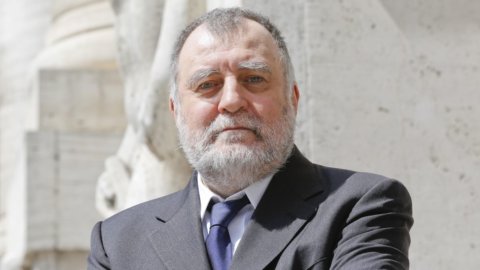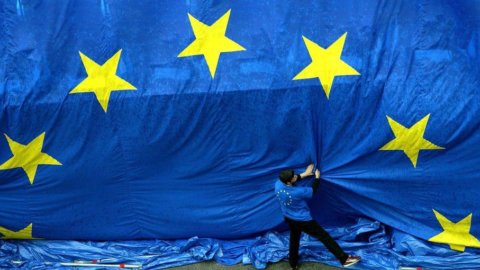Last week, Chancellor Merkel received President Macron not in the Kanzlei, her official residence, but in the imposing Berlin Castle, the historic palace of Prussian monarchs and German emperors. Semi-destroyed during the war, the Berliner Schloss had been razed to the ground by the GDR as a symbol of feudal militarism and the large freed space had been renamed, for the avoidance of doubt, Marx-Engels-Platz. The reconstruction required twenty years of debates and ten of real building work and has produced a political-architectural compromise, a non-copy copy that will have a more modern look and a different name, Humboldtforum. For Berliners, as evidenced by the relief and emotion that surrounded the story, that will always remain the old castle, symbol of the city for centuries.
If there will be some slight difference between the Humboldtforum and the old castle, this will not be the case for Frankfurt's Altstadt, the old city that an army of craftsmen is finishing rebuilding meticulously identical to the one that was bombed in 1942-45 to be later replaced by one gigantic hideous administration building after the war. It is the same spirit with which the center of Warsaw was rebuilt in recent years, today an exact copy of what it was in 1939.
In many cultures, as can be seen, a total reconstruction of an ancient work is philologically correct as long as the copy is exactly the same as the original. In others, like ours, this is anathema. For us, in fact, only the conservation of what is left is correct. Any restoration must be light and conservative and, where possible, it should be highlighted. The ruins, for their part, are romantically beautiful in themselves.
The result of these two opposing visions is that in the German approach we find ourselves thrilled, as observers, by recent reconstructions that don't even have a grain of sand of the original while in the Italian approach we get excited by ruins that no longer resemble nothing to what they were originally. As for light restorations, these, over time and little by little, tend in any case to distance today's work from the original.
The problem of the permanence of identity over time was already well known to the Greeks. Was the ship of Theseus, of which a piece was changed every year, still the same ship after a long period of time or did it become something completely different? Anglo-Saxon metaphysicists and Google ontologists still debate it today.
For investors, the period from 2016 to 2020 appears to be an apparently stable and positive continuum. Hopefully there will be no shocks or recessions, nor will we see sudden policy changes. At the end of this arc, however, nothing will be as it was at the beginning after many retouches and often it will even have the opposite sign.
What differentiates this cycle from the previous ones are the extreme slowness and gradualness of the changes, sometimes artfully studied to be imperceptible. The challenge for investors is to change their investment strategy and style in an equally gradual and imperceptible way.
An impossible challenge, just as it is impossible to grasp differences from the day before in the face we see in the mirror every morning. Only by looking at an old photo will we realize the changes.
However, the challenge becomes manageable if we manage to make the continuum discrete, dividing it into phases. It's a somewhat arbitrary operation, but it's essential if we don't want to end up like the proverbial frog who feels the water in the pot slowly rise in temperature and who, not knowing how to give himself an endurance limit, however arbitrary, ends up boiled.
We therefore divide the period 2016-2020 into three phases characterized by three different approaches to investment.
The first, 2016-2017, is that of a positive mini-cycle within a long positive cycle. Inflation is low, liquidity is abundant and growth is accelerating. Rates are extraordinarily low and support both bonds and equity multiples. The investment strategy is simple, it is offensive and includes shares, credits and bonds in order.
The third, from mid-2019 to the end of 2020, sees a slowing global economy (with some risk of a modest recession), tighter liquidity, inflation and higher rates. You can still try to earn here and there but, as they say in English, it will be like collecting coins in front of a steamroller who is coming towards us. It will be interesting for arbitrageurs, but for most investors it will be playing defense or counterattack with small positions.
In between, from late January 2018 to mid-2019 (or sooner if there are political complications in America), there is a transition phase in which we will have to keep some points in mind.
- Strongly growing equity earnings related to US tax reform were largely discounted in advance last year. Celebrating them again this year would mean counting them twice.
- US rates will continue to rise, albeit gently. With higher rates, equity multiples will have to slowly contract. To have new stock market highs (not easy but not impossible either) we will have to have profits three times as high. High to meet expectations, high to beat them and high to offset the rise in interest rates.
- The inverted yield curve, if that is the case, will not be a tragedy as the markets seem to think, but the overall rise in the curve, yes, will begin to weigh not so much on the profits of the companies (which have put in a lot of liquidity) as on the propensity to get into household debt.
- Even after Draghi, Europe will continue to normalize very slowly. Rates, now below zero, will be zero at the end of 2019 and if the ECB ever wants to start reducing its balance sheet in the wake of the Fed, this will not happen before mid-2020. Italy will probably offer the pretext to postpone as much this decision possible.
- The euro, faced with a further widening interest rate differential with America, will remain in limbo. In phases like the current one, characterized by a less brilliant European economy than expected and with large short dollar positions still to be closed, we will perhaps see the 1.20 threshold breached, but it will not be long before a tweet from Trump calls all 'order. A reacceleration of growth, according to Draghi probable, will bring us back close to 1.25.
In practice, the strategy for this transition phase will have to be neutral. The risks, which until January were only positive surprises, will be symmetrical. If we still have the mindset from 2017 (which we see reemerging every time the SP moves back above 2700) let's change that. From fifth gear we downshift to third and get ready for second for next year. It's not the end of the world. If anything, it is a return to a normal world.





